
Worms that infect a person's internal organs are called helminths. According to statistics, today about 30% of the general population is susceptible to helminthic infestation. Worms that poison the body can infect any part of the body. This is dangerous only for diseases that can cause helminths. Its presence in the body can be fatal.
To date, helminthiasis can be completely treated not only with drugs, but also with folk remedies. Each type has its own treatment. Therefore, it is worth knowing and understanding the types of worms and the symptoms of parasitic infection in order to take timely action.
Classification of helminthiasis
Parasitic worms are divided into two major groups: intestinal and tissue.
The first species lives directly in the intestines. This group includes:
- roundworms and pinworms;
- ankylosing spondylitis and lamblia;
- whipworms and dwarf tapeworm;
- cattle and broad-banded worm;
- pig tapeworm.
Tissue worms live in any organ of the human body and can parasitize for many years. These include:
- cysticercus and trematodes;
- a mixture of trichinella and liver;
- echinococcus and alveococcus.
Round worm
These are the most common and insidious types of worms that live in the small intestine of an adult or child. This type of helminth infection is called ascariasis.
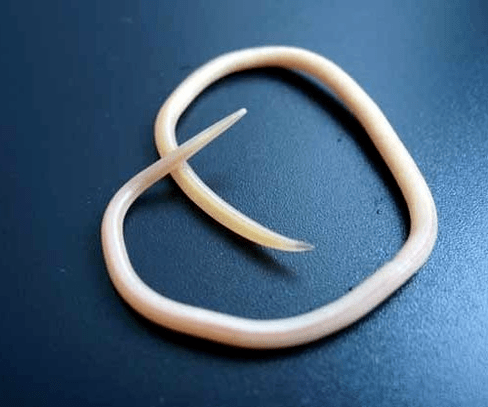
In the first days of the heat, a person begins to feel weakness, nervousness, fever, shortness of breath, cough and chest pain. Such symptoms are due to the fact that helminths primarily affect the respiratory system.
Infection can be caused by drinking raw water from unapproved sources, poorly processed fresh fruits and vegetables. The risk of ascariasis increases in the summer months.
Pinworms
Small helminths that live in the intestines cause a disease called enterobiasis. The worms lay their eggs in the anal area. The ovaries turn into larvae and can enter the body only through the oral cavity.
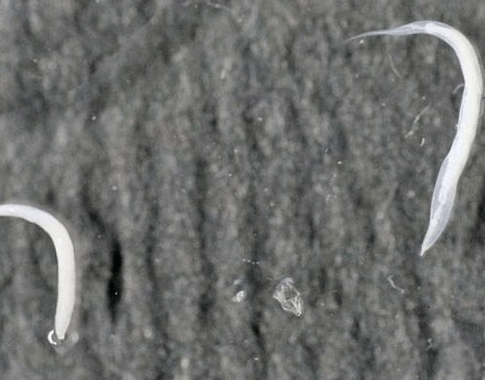
Re-infection occurs when a person suffering from enterobiosis comes in contact with food eaten by dirty hands. Symptoms of infection may include itching and increased irritation around the anus.
It is important! The disease is carried by humans.
Angurt established
Infection with hookworm infection occurs through damaged skin in contact with the larvae of this type of worm.
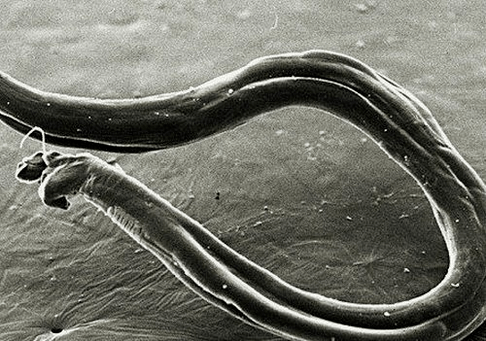
Hookworms follow the same path as roundworms before entering the intestines.
Symptoms include cough, lower abdominal pain, nausea, and stool discomfort. This type of helminthiasis can cause anemia.
Giardia
Giardiasis progresses in people who have a habit of biting their nails and other objects (pens, pencils). Infection can also occur from drinking poor quality water, unwashed products, contact with dirty clothes that may contain larvae, and from being a carrier of the disease.
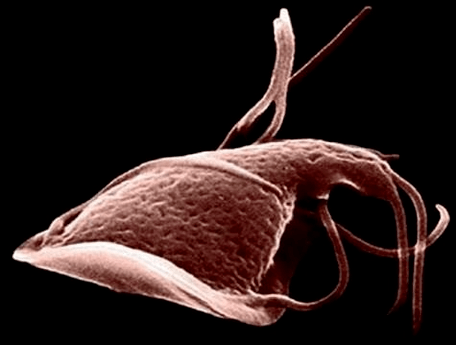
Symptoms of infection may include fecal incontinence and lower abdominal pain.
Vlasoglava
Trichocephalosis occurs during infection with corn larvae. They come in with unprocessed fruits and vegetables. Dirty hands and water are also vectors.
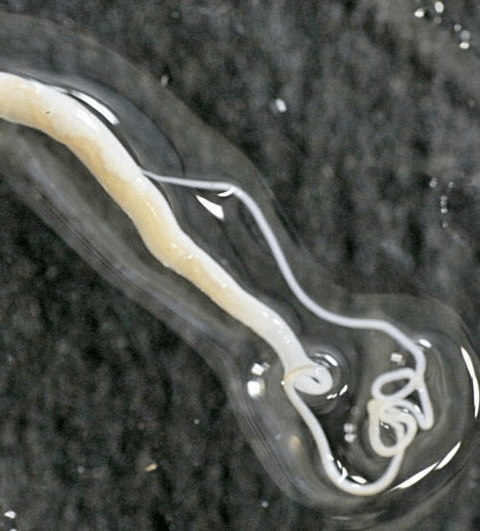
Occupancy is accompanied by severe abdominal pain, diarrhea and loss of appetite. The symptoms of the infection are often similar to the symptoms of appendicitis.
Dwarf tapeworm
Infection with worms occurs not only through dirty hands and unwashed food, but also insects can be carriers.
Dwarf tapeworm causes inflammation and poisoning by affecting the intestines and liver.
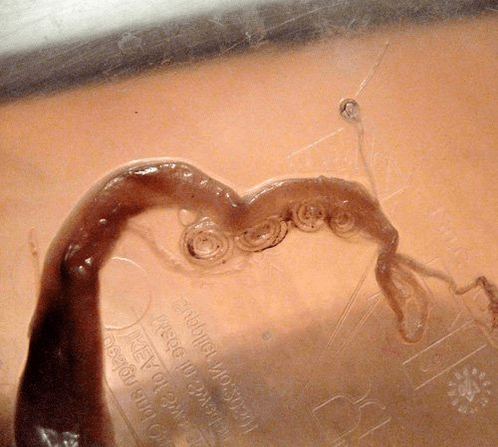
Hymenolepiasis may be accompanied by the appearance of dysbiosis, loss of appetite, increased thirst, fatigue and increased nervousness.
Beef ribbon
It is one of the most dangerous types of worms that parasitize the large intestine.
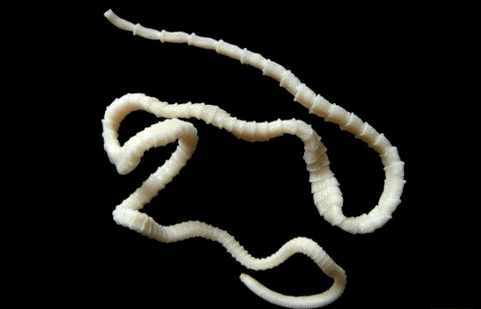
The length of an adult worm reaches several meters. The individual takes all the nutrients from the human body and causes severe intoxication.
Symptoms of heat:
- diarrhea and abdominal pain;
- vomiting and nausea;
- restless sleep;
- dizziness and fainting.
The risk of teniarinhosis arises from eating undercooked beef contaminated with bovine tapeworm larvae.
Wide ribbon
The cause of diphyllobotriasis is the consumption of poorly processed fish products and caviar.
The worm that causes the disease is one of the largest and can grow up to ten meters.

Symptoms of infection include severe lower abdominal pain and anemia.
The pig tied the ribbon
Infection with this type of helminths is extremely dangerous for humans. Eating undercooked pork can cause Finns to enter the body and mature.
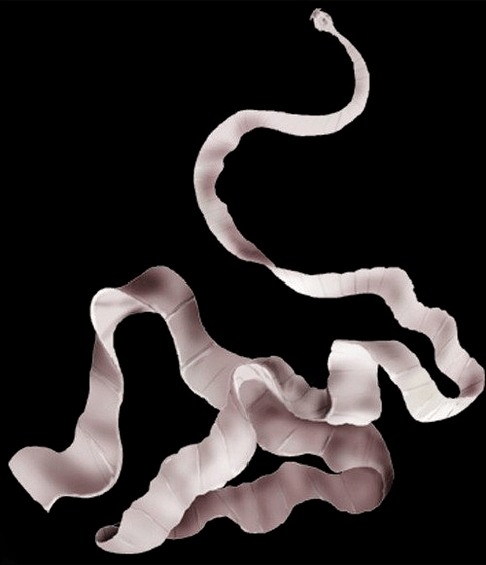
The pork is separated from the tapeworm's body by so-called segments that can enter the environment and leave the body spontaneously with the anus or feces. The symptoms of teniasis are similar to those of bovine tapeworm infection.
Cysticerki
The pig created a kind of tissue that is the product of the tapeworm segment. Segments containing worm eggs enter the external environment and can re-enter the body through external environmental objects and lead to the development of cysticercosis.
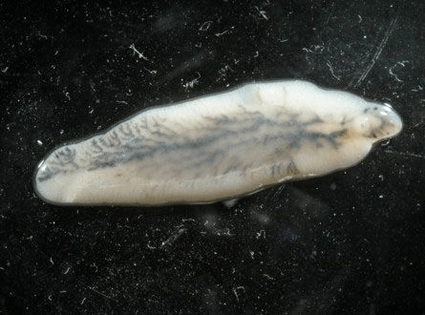
Parasites live in the muscles, myocardium and even the brain.
It is important! It has a squeezing effect on the organs and causes inflammation.
Hepatic hemorrhage
Opisthorchiasis occurs when liver fluke larvae enter the human body along with infected fish.
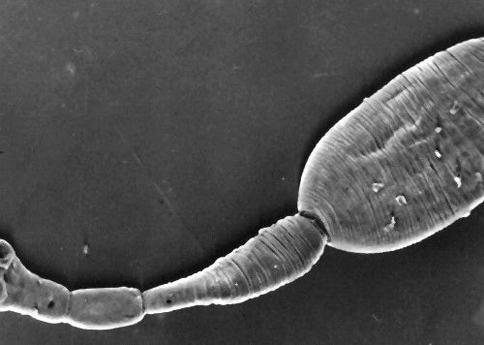
Signs of opisthorchiasis:
- nausea;
- diarrhea;
- pains of the whole body;
- occurrence of allergies.
More severe symptoms are chronic. This type of parasite is dangerous for the development of liver cancer.
Echinococcus
The worm is located in the body, most often in the liver or lungs. Echinococcus can cause the formation of a cyst and tumors in the affected organ. The infection can be fatal.
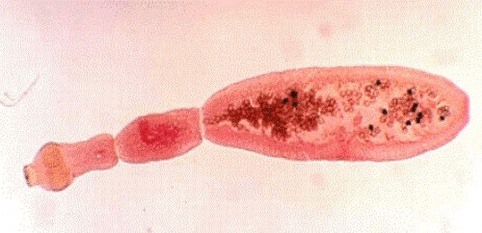
Larvae come into contact with sick animals.
Trichinella
Trichinosis primarily affects people who eat poorly processed meat of wild animals. Pigs can also be carriers of Trichinella.

Adults in the human body live in different types of muscles (breathing, face, etc. ).
In the early stages, nausea and loose stools occur. Further symptoms of heat are fever, edema, skin rash, muscle pain. Infection with this type of parasite without timely treatment can be fatal.

Ways of human infection with helminths
- Biohelminthiasis (infection from animals).
- Infectious helminthiasis (transmitted from person to person).
- Geohelminthiasis (diseases caused by parasites that carry out one of the life cycles on earth).
Factors affecting the manifestations of helminthiasis
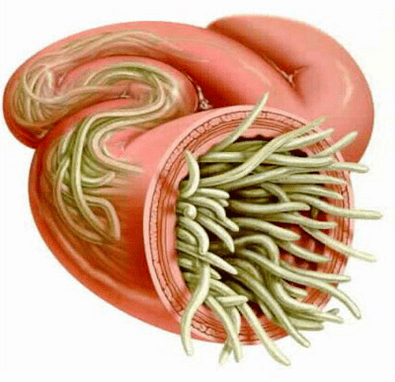
The way the parasite enters the body;
- The degree of adaptation of the helminth to the human body;
- Population density (number) of parasitic individuals;
- Worm habitat (tissue parasites live in the thickness of soft tissues, and luminal ones live in the cavities of empty organs). Some helminths in different phases have both luminal and tissue forms. The larval and developmental stages of worms, as a rule, lead to more pronounced pathological changes.
In the absence of re-infection, the number of adult parasites in the human body does not increase. This feature significantly distinguishes helminthic invasions from diseases caused by bacteria, viruses, fungi and protozoa.
Worms in humans: symptoms
Helminthiasis is a disease characterized by 2 stages of the course (acute, two weeks to two months) and chronic (several months to several years).
Symptoms of the acute stage of helminthiasis
The first signs of the disease may appear at different times (after 2-3 weeks at most, with ascariasis - after 2-3 days, and the incubation period with filariasis can last 6-18 months).
The most characteristic symptom in the acute phase of parasitic invasion is an allergic reaction (antibodies are produced to the antigens of migrating parasitic larvae). People infected with worms often develop itchy rashes on the skin, prone to recurrent course, enlarged regional lymph nodes, and may develop generalized or local edema, muscle and joint pain. Migrating parasitic larvae can also cause chest pain, coughing, choking attacks, fecal incontinence, nausea and vomiting.
Symptoms of chronic helminthiasis
The symptoms of the chronic phase are directly related to which organ is "inhabited" by parasites, while their size and number play an important role.

Thus, the disease may be asymptomatic when parasitized in the intestines of single individuals (except in cases of infection with very large parasites). Characteristic symptoms of the chronic stage of intestinal helminthiasis are dyspeptic diseases. Asthenoneurotic and pain syndromes are more common in children. Mass invasion of roundworms can lead to the development of intestinal obstruction, obstructive jaundice and pancreatitis.
In people suffering from helminthiasis, the risk of malignant tumors is significantly increased due to weak immunity and the process of cell division (as a result of the constant regeneration of tissues damaged by parasites).
Types of helminths that parasitize the human body
The causative agents of human helminthiasis are 2 types of worms: round (nematode) and flat (tapeworm and flukes).
Roundworms
Pinworm
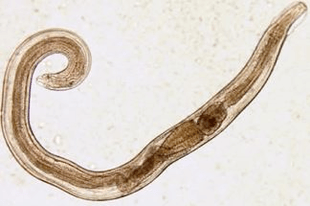
The parasites that cause enterobiosis are small (up to 10 mm) thin hollow worms that are grayish-white in color. The infection is edible (orally). This is due to dirty hands. The parasite's eggs are found in soil, in the wool of infected animals, in unwashed vegetables and fruits, and so on. Can be found. At the same time, cases of spontaneous infection as a result of scratching with enterobiasis are common. ingestion of itchy areas and subsequent ovulation. Pinworm larvae develop in the digestive system within two weeks. When it becomes an adult, the worm parasitizes the lower and upper parts of the colon.
Ascaris
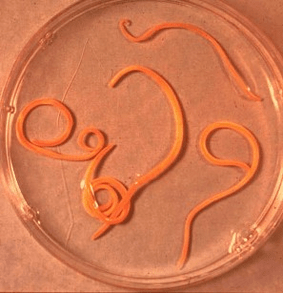
Ascaris is a reddish-yellow, large spindle-shaped parasite that reaches 40 cm (females) and 15-25 cm (males) in adulthood. Without suction cups or other fastening devices, the roundworm can move independently towards food masses. Eggs laid by the parasite's teeth are discarded along with feces.
Vlasoglav
Vlasoglav, the causative agent of trichocephalus, is a white helminth that parasitizes in the early part of the large intestine and reaches a size of 4-5 cm.
Trichocephalus with a small number of worms is asymptomatic. In a severe stage (mass invasion), the patient develops abdominal pain, sometimes severe diarrhea accompanied by rectal prolapse. This condition is most common in debilitated children. With a moderate stage of trichocephalus, a child's growth retardation is possible.
Trichinella
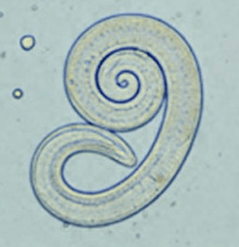
The causative agent of trichinosis is a small round helminth that reaches a length of 2-5 mm. The infection occurs when eating poorly roasted meat (pork, bear meat, boar). The larvae of the parasite, which penetrate the intestines, mature in 3-4 days to the condition of a sexually mature individual. The life of the worm is 40 days, after which the parasite dies. By piercing the intestinal wall, the larvae enter the bloodstream and are located in the muscles and carried to all organs of the human body. In this condition, the respiratory and facial muscles, as well as the flexor muscles of the limbs, are most affected.
In the first days after the occupation, patients complain of abdominal pain. Then, after about 2 weeks, the body temperature rises to 39-40 C, itchy rashes appear on the skin, muscle pain develops and the face swells. During this period, in the case of a mass infection, the risk of death is high. After about a month, the patient recovers. The parasite is encapsulated in a spiral, and then dies within two years.
Hookworm and some
These two parasites are similar in both their biological properties and the diseases they cause. In this regard, it is customary to combine them under a common name (hookworms). Worms up to 10-15 mm in length are parasitized at 12 p. m. intestine. It should be noted that this is one of the most common, but also very rare parasites. When the larvae come in contact with contaminated soil, they enter the human body through the skin. In addition, they enter the bloodstream and, like roundworms, migrate to the lungs, where they then enter the digestive system through the bronchi, along with expectorant sputum. Hookworm parasitizes in the intestine, attaches itself to the intestinal wall. Therefore, the most characteristic symptom of this helminthiasis is iron deficiency anemia, as well as a change in the ratio of protein fractions (dysproteinemia).
Straight worms
Wide ribbon
This is one of the largest helminths, reaching a length of 10-20 meters. The disease caused by this parasite is called diphyllobotriasis. The developmental period of the worm begins with freshwater fish or crustaceans. The larva enters the human body with the egg or infected fish fillet, which is the final owner of the tapeworm. The parasite attaches to the wall of the small intestine and grows in an adult for 20-25 days.
Diphyllobotriasis occurs against the background of disorders of the digestive system and B12 deficiency anemia.
Hepatic hemorrhage
The parasite that causes opisthorchiasis is a flatworm 7-20 mm long. Human infection occurs when eating contaminated fish meat that has not received adequate heat treatment. The larvae of the liver, which come out of the small intestine, penetrate the bile ducts and gallbladder, where they are secured with two suction cups.
In the stage of acute helminthiasis, the patient has pain in the upper abdomen, fever, nausea, muscle pain, diarrhea and skin rashes are possible. Chronic opisthorchiasis manifests itself with symptoms of hepatitis, inflammation of the bile ducts, cholecystitis, digestive disorders, nervous disorders, weakness and increased fatigue. The parasite causes irreversible changes, and the patient does not suffer from chronic inflammatory processes and functional disorders even after expulsion.
He built beef and pork
The length of these parasites, which are almost identical in structure, reaches 5-6 meters. Infection with teniarinhoses and teniasis occurs due to the consumption of meat from cattle or pork (one of the intermediate forms of helminthiasis) infected by Finns. Presented in the form of whitish bubbles up to 0. 5 cm in size, living Finns cling to the wall of the human small intestine and become an adult in 3 months. The tape parasite, which consists of more than 2, 000 segments, is constantly growing.
Echinococcus
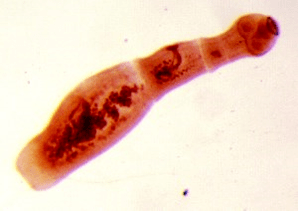
For this parasite, a human is an intermediate host. The worm parasitizes the human body in the form of Finns. The final owner of the echinococcus is a wolf, dog or cat. The infection comes in contact with animals and environmental objects planted with Echinococcus eggs. Once inside the gut, oncospheres (six-hooked larvae) develop from them. They enter the bloodstream from the intestines and travel throughout the body.
Alveococcus
This parasite, which is considered a type of echinococcus, causes the most dangerous helminthiasis (alveococcosis), similar in severity to cirrhosis and liver cancer. Infection occurs when oncospheres (eggs with adult larvae) penetrate the intestines. Laurocysts are very aggressive formations that grow continuously due to expanding bubbles and also have the ability to grow in the liver as cancerous metastases. Necrotic changes due to disorders of blood vessels are accompanied by necrotic changes in nearby tissues. Alveococcus, which spreads to nearby structures, forms fibrous nodules with the insertion of multi-chambered bubbles. This condition can last for several years and therefore requires mandatory surgery.
Diagnosis of helminthiasis
Diagnosis of helminthic infestations includes the following activities:
- careful collection of medical history to help identify possible causes of infection;
- feces, blood, intestinal composition 12p, rectal and perianal mucus, muscle tissue, pulmonary sputum, bile laboratory examinations. Eggs, segments or parasitic fragments may be detected during the analysis. At the same time, the increased content of eosinophils in the blood is a signal of the presence of helminthiasis.
- When diseases caused by larval stages or tissue parasites are diagnosed, serological tests are performed (ELISA, RSK, indirect agglutination test, immunofluorescence analysis, etc. ).
- Ultrasound, CT and endoscopic examinations are prescribed to identify worms that affect the liver tissue.
Worms in humans: treatment
In the acute stage of parasitic infection, the patient is prescribed detoxification and desensitization therapy. In severe cases of the disease (liver trematodes, trichinosis), glucocorticoids are used according to medical indications.
Specific anthelmintic chemotherapeutic agents are prescribed as specific therapy drugs, taking into account the nature of the pathogen.
In parallel, the patient is recommended to take antihistamines and enterosorbents. The final stage of treatment involves the use of probiotics that normalize the intestinal microflora.
A special delicate diet is also prescribed (food should be digested and low in fat).
During antihelminthic therapy, the patient is required to adhere to strict personal hygiene (to prevent re-infection). At the same time, for many helminthiases, all family members and those in constant contact with an infected person should be treated.
Lack of knowledge about the biology of these creatures and the ways in which they can be infected, as well as underestimation of their dangers, have led to at least a few billion people now carrying certain parasites.
Parasites can be present not only inside a person, but also outside the human body.
Prevention of parasitic invasion
Rule # 1:you cannot eat enough salted, fried or boiled fish. Sushi, lightly salted herring or sashimi can be considered a gourmet dish. But in essence it is a raw fish, and fish is one of the components of the life cycle of parasitic worms.
How everything happens:First, the larva enters a mollusk that has not grown too much, then the fish eats the mollusk, the larva enters the digestive system live, then grows and multiplies, enters the muscle tissue of the fish, then this fish is eaten by a dolphin, gull or polar bear. Or a restaurant visitor who decides to join the high Japanese culture.
Safe raw fish exists in theory. To do this, it must either be frozen immediately after capture and thawed before cooking, or grown in a special fish farm to control the absence of parasites. However, it is generally not possible to check whether a risky food is actually made from it.
The same care should be given to meat; Do not try raw minced meat and freshly salted pork.
In addition, hands should be washed before eating vegetables to prevent helminth infections. As part of the natural environment, these parasites have been found to be widespread almost everywhere in the human body.
Any contact of food or hands with the ground, dust and vegetation can lay microscopic eggs on the food. If they enter the intestines, worms will come out of the eggs, and it will not be easy to remove them.
There are parasites that attack a person walking or resting in nature, for example:
- Plasmodium malaria in the saliva of mosquitoes of the genus Anophel,
- the causative agent of encephalitis in the saliva of ticks,
- fly gadfly and wolfarth.
Their prevention is the use of all kinds of repellents when walking in the wild and maximum protection of exposed areas of the body (mosquito nets, special gel).
But what can you do if prevention has not helped? Since the attack has long been known, folk remedies have also been known for a long time.
As a result, simple hygiene and sanitation, extermination of flies and cockroaches, can significantly reduce the risk of parasitic infections and lead to serious consequences.
























